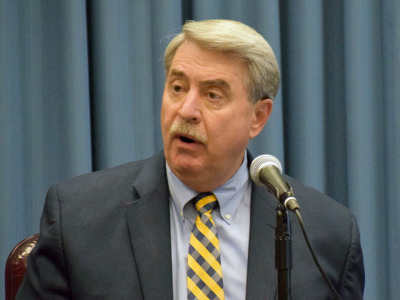More than 1,000 people gathered in Washington this week for what amounted to a dry run for the next United Nations climate conference in December, where discussion of food systems will be front and center.
“We're hosting COP 28 and inviting the world. And I'm really making sure that food systems have the attention and central stage,” said Mariam Almheiri, minister of climate change and environment in the United Arab Emirates, the co-leader with the United States of the Agriculture Innovation Mission for Climate (AIM4C). COP 28 stands for the 28th meeting of the Conference of the Parties, scheduled for Dubai from Nov. 30-Dec. 12.
Her promise to put food systems at the forefront received a hearty round of applause from the packed ballroom at the J.W. Marriott hotel just a few blocks from the White House.
“There's still a lot of work to do and I promise you we will make sure that COP 28 will be a game-changer,” Almheiri said
The summit brought together a diverse range of agricultural stakeholders, including companies and nongovernmental organizations. Numerous representatives of AIM4C partner countries also were in attendance, including nearly 40 agricultural ministers.
The audience heard from former Vice President Al Gore, who discussed research on his farm in Tennessee in an onstage interview conducted by Ag Secretary Tom Vilsack on Monday. Senate Agriculture Committee Chairwoman Debbie Stabenow, D-Mich., also spoke, telling the crowd that this year, “more than 345 million people, more people than the entire population of the United States, will be food-insecure around the globe this year.”
“Our farmers and ranchers are on the front lines of the climate crisis; it's hitting them in the head every day,” Stabenow added, noting that “climate-driven weather events destroyed about 90% of my state's tart cherry crops” more than a decade ago.
She, like so many in the ag sector, emphasized agriculture’s potential to help combat the climate crisis. Hearkening back to the Dust Bowl’s impact in forcing farmers to adopt conservation practices, Stabenow declared “we are at another turning point now.
 Senate Ag Committee Chair Debbie Stabenow, D-Mich.
Senate Ag Committee Chair Debbie Stabenow, D-Mich.
“Over the last decades, we have seen the ecological consequences of how we farm; fertilizer runoff fuels algae blooms that are choking our waters, pesticides contribute to crashing pollinator populations,” she said. “Our farms still release more carbon into the air than they retain in the soil. But the good news is that this is changing.”
Tom Arnold, chair of Ireland’s 2030 Agri-Food Strategy Committee, echoed Stabenow’s sentiment. In an interview on the sidelines of the summit, Arnold said the benefit of the summit is “just the acknowledgment of this important link between food and climate.”
The food sector will have to become more efficient at increasing production while reducing its creation of greenhouse gases, Arnold said. “And then the other side of that story is that we need to tackle the climate issue so that it is not having such a negative effect on food production.”
AIM4C can help by emphasizing the need for innovation in the ag space. Almheiri said, “For me when I think of AIM for Climate, it's really about innovation and sharing knowledge and about combating climate change.”
Arnold characterized the summit as “a steppingstone toward” the December meeting.
The COP process has been “justifiably criticized” for not stressing the importance of ag and food, he said, also mentioning a commitment made in 2009 by nations to raise $100 billion to help poorer counties tackle climate change.
Don’t miss a beat! It’s easy to sign up for a FREE month of Agri-Pulse news! For the latest on what’s happening in Washington, D.C. and around the country in agriculture, just click here.
“That has never actually happened,” he said. “And I think there are more serious conversations going on now about the need for substantial climate financing. So let’s see how that goes.”
Ertharin Cousin, founder and CEO of Food Systems for the Future, said the agri-food sector must acknowledge its complexity. “We must accept as a community that there is no one solution or one way forward,” she said. “What does that mean? It means in rooms like this one, we must not fight each other. We are our own worst enemy.”
Instead, she said, there needs to be a place for alternative livestock management and alternative proteins. “As a community, our principles must align and provide space for sustainable intensification as well as for organic," she said.
Ted McKinney, CEO of the National Association of State Departments of Agriculture, said despite some doubts about the summit because of its lack of representation from producers, “I am impressed so far. I think the administration is pulling together the globe and reminding them that things like innovation are important in agriculture, something that we’ve believed in the U.S. for a long time.”
 Ted McKinney, NASDA
Ted McKinney, NASDA
The summit is giving the U.S. a chance to demonstrate its progress with other countries “who may not be quite where the U.S. is on innovation and advancements,” said McKinney, who was USDA's trade undersecretary during the Trump administration. “And I think most importantly, people are seeing that they can be a partner here, and that ag is part of the solution, not the problem.”
AIM4C announced that nations have now committed $10 billion in investments, up from $8 billion announced last fall. And nongovernmental entities have now committed about $3 billion as part of 51 “innovation sprints” addressing a variety of topics, including methane reduction and seed design for climate-smart agriculture systems.
The number of sprints is up from the 30 announced earlier. And the number of AIM4C partners now totals more than 500, including the nations of Argentina, Fiji, Guatemala, India, Panama, Paraguay and Sri Lanka.
Meanwhile, USDA used the summit to officially launch the International Climate Hub website, which the department says “will enable science-based, climate-informed agricultural decision-making by providing information and resources tailored to specific regions and needs, including a focus on the countries and producers most vulnerable to the effects of global climate change.”
USDA also released its research and science strategy for 2023-26, which identified five priorities: “Accelerating innovative technologies and practices; driving climate-smart solutions; bolstering nutrition security and health; cultivating resilient ecosystems; and translating research into action.”
For more news, go to www.Agri-Pulse.com.


